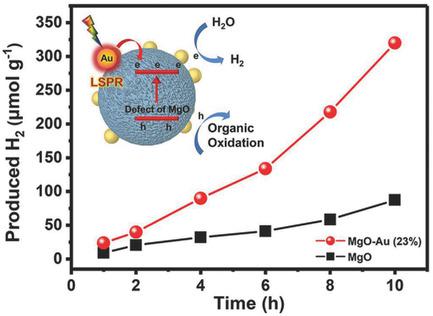Our official English website, www.x-mol.net, welcomes your feedback! (Note: you will need to create a separate account there.)
Photoactivity and Stability Co‐Enhancement: When Localized Plasmons Meet Oxygen Vacancies in MgO
Small ( IF 13.3 ) Pub Date : 2018-10-17 , DOI: 10.1002/smll.201803233 Zhengqing Liu 1 , Ziyang Lu 2 , Michel Bosman 3 , Na Li 4 , Terry J. Frankcombe 5 , Guohua Jia 6 , Antonio Tricoli 7 , Yun Liu 2 , Yaping Du 1 , Zongyou Yin 2
Small ( IF 13.3 ) Pub Date : 2018-10-17 , DOI: 10.1002/smll.201803233 Zhengqing Liu 1 , Ziyang Lu 2 , Michel Bosman 3 , Na Li 4 , Terry J. Frankcombe 5 , Guohua Jia 6 , Antonio Tricoli 7 , Yun Liu 2 , Yaping Du 1 , Zongyou Yin 2
Affiliation

|
Durability is still one of the key obstacles for the further development of photocatalytic energy‐conversion systems, especially low‐dimensional ones. Encouragingly, recent studies show that nanoinsulators such as SiO2 and MgO exhibit substantially enhanced photocatalytic durability than the typical semiconductor p25 TiO2. Extending this knowledge, MgO–Au plasmonic defect nanosystems are developed that combine the stable photoactivity from MgO surface defects with energy‐focusing plasmonics from Au nanoparticles (NPs), where Au NPs are anchored onto monodispersed MgO nanotemplates. Theoretical calculations reveal that the midgap defect (MGD) states in MgO are generated by oxygen vacancies, which provide the main avenues for upward electron transitions under photoexcitation. These electrons drive stable proton photoreduction to H2 gas via water splitting. A synergistic interaction between Au's localized plasmons and MgO's oxygen vacancies is observed here, which enhances MgO's photoactivity and stability simultaneously. Such co‐enhancement is attributed to the stable longitudinal‐plasmon‐free Au NPs, which provide robust hot electrons capable of overcoming the interband transition barrier (≈1.8 eV) to reach proton reduction potential for H2 generation. The demonstrated plasmonic defect nanosystems are expected to open a new avenue for developing highly endurable photoredox systems for the integration of multifunctionalities in energy conversion, environmental decontamination, and climate change mitigation.
中文翻译:

光活性和稳定性共同增强:当本地等离子遇到MgO中的氧空位时
耐久性仍然是进一步发展光催化能量转换系统(尤其是低维系统)的主要障碍之一。令人鼓舞的是,最近的研究表明,纳米绝缘体(例如SiO 2和MgO)比典型的半导体p25 TiO 2表现出显着增强的光催化耐久性。。扩展了这一知识,开发了MgO–Au等离子体缺陷纳米系统,该系统结合了MgO表面缺陷的稳定光活性和Au纳米颗粒(NPs)的能量聚焦等离子体,将Au NP锚定在单分散的MgO纳米模板上。理论计算表明,MgO中的中间能隙缺陷(MGD)状态是由氧空位产生的,氧空位为光激发下的向上电子跃迁提供了主要途径。这些电子驱动稳定的质子光还原为H 2气体通过水分解。这里观察到金的局部等离子体激元和MgO的氧空位之间的协同相互作用,这同时增强了MgO的光活性和稳定性。这种共增强归因于稳定的无纵向等离振子的金纳米粒子,该纳米粒子提供了强大的热电子,能够克服带间跃迁势垒(约1.8 eV),从而达到产生H 2的质子还原潜能。被证明的等离子缺陷纳米系统有望为开发高度耐用的光氧化还原系统开辟一条新途径,以在能量转换,环境净化和减轻气候变化方面整合多功能。
更新日期:2018-10-17
中文翻译:

光活性和稳定性共同增强:当本地等离子遇到MgO中的氧空位时
耐久性仍然是进一步发展光催化能量转换系统(尤其是低维系统)的主要障碍之一。令人鼓舞的是,最近的研究表明,纳米绝缘体(例如SiO 2和MgO)比典型的半导体p25 TiO 2表现出显着增强的光催化耐久性。。扩展了这一知识,开发了MgO–Au等离子体缺陷纳米系统,该系统结合了MgO表面缺陷的稳定光活性和Au纳米颗粒(NPs)的能量聚焦等离子体,将Au NP锚定在单分散的MgO纳米模板上。理论计算表明,MgO中的中间能隙缺陷(MGD)状态是由氧空位产生的,氧空位为光激发下的向上电子跃迁提供了主要途径。这些电子驱动稳定的质子光还原为H 2气体通过水分解。这里观察到金的局部等离子体激元和MgO的氧空位之间的协同相互作用,这同时增强了MgO的光活性和稳定性。这种共增强归因于稳定的无纵向等离振子的金纳米粒子,该纳米粒子提供了强大的热电子,能够克服带间跃迁势垒(约1.8 eV),从而达到产生H 2的质子还原潜能。被证明的等离子缺陷纳米系统有望为开发高度耐用的光氧化还原系统开辟一条新途径,以在能量转换,环境净化和减轻气候变化方面整合多功能。


























 京公网安备 11010802027423号
京公网安备 11010802027423号